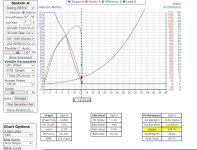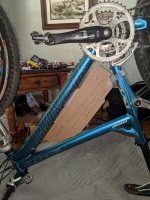geosped
100 W
- Joined
- Mar 18, 2015
- Messages
- 258
Hi,
was hoping someone with experience can answer. I'm about to take the plunge and buy a bfang BBSHD 1000w mid drive kit and install on a full suspension mountain bike. I was wondering what size batteries I should consider. I'm assuming it's almost impossible to guess based on the fact that there are so many variable to account for.
Some Context:
1)I'm 250lbs
2) I live in North Georgia, My favorite trails are Chickopee Woods(cumming GA), Blankets Creek(Woodstock), Yellow River(Stone Mountain), Foe Killer Creek(Roswell). Carter Lake and Bull Run, Doubt that helps anyone but just incase.
3) Off road use only. The mountain trail system I use most often has a 1.6mile loop and a 3.4 mile loop. On a very good day I'll do 5 laps. Which is roughly 17 miles with several breaks in between. The track is mostly technical single track a lot switch backs, roots some downhill I would say the highest climb is 400 yards at a 10% grade. I hate getting off and walking half way up. I always pedal so I wont just be coasting. This is supposed to be fun exercise for me.
4) I understand that Samsung, Panasonic, and LG make the best individual cells. I also understand that Luna Cycle, ebikes.ca and EV3EM out of China also make good quality batteries. So I will be purchasing one from one of these vendors. Any other vendors I should consider? Which cells are the best? I understand that Samsung 30q are very good batteries but for my use case I would rather save a few bucks and get something that can provide me with a bit more range. For example a pack with 3500mah cells instead of 3000mah cells.
Based on the above information what size battery would you recommend? Also how long does it take to charge a 14ah battery at 2a vs 5a if depleted at 70%
I was considering a 10ah, 14ah or 17ah 52v pack. Thoughts and suggestions most welcome.
Thanks in advance for your response.
was hoping someone with experience can answer. I'm about to take the plunge and buy a bfang BBSHD 1000w mid drive kit and install on a full suspension mountain bike. I was wondering what size batteries I should consider. I'm assuming it's almost impossible to guess based on the fact that there are so many variable to account for.
Some Context:
1)I'm 250lbs
2) I live in North Georgia, My favorite trails are Chickopee Woods(cumming GA), Blankets Creek(Woodstock), Yellow River(Stone Mountain), Foe Killer Creek(Roswell). Carter Lake and Bull Run, Doubt that helps anyone but just incase.
3) Off road use only. The mountain trail system I use most often has a 1.6mile loop and a 3.4 mile loop. On a very good day I'll do 5 laps. Which is roughly 17 miles with several breaks in between. The track is mostly technical single track a lot switch backs, roots some downhill I would say the highest climb is 400 yards at a 10% grade. I hate getting off and walking half way up. I always pedal so I wont just be coasting. This is supposed to be fun exercise for me.
4) I understand that Samsung, Panasonic, and LG make the best individual cells. I also understand that Luna Cycle, ebikes.ca and EV3EM out of China also make good quality batteries. So I will be purchasing one from one of these vendors. Any other vendors I should consider? Which cells are the best? I understand that Samsung 30q are very good batteries but for my use case I would rather save a few bucks and get something that can provide me with a bit more range. For example a pack with 3500mah cells instead of 3000mah cells.
Based on the above information what size battery would you recommend? Also how long does it take to charge a 14ah battery at 2a vs 5a if depleted at 70%
I was considering a 10ah, 14ah or 17ah 52v pack. Thoughts and suggestions most welcome.
Thanks in advance for your response.



